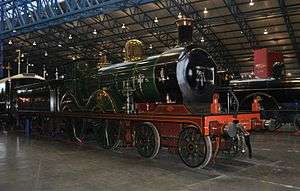SECR D class
The SECR D class is a class of 4-4-0 tender locomotives designed by Harry Wainwright for the South Eastern and Chatham Railway.
| SECR D class | |||||||||||||||||||||||||||||||||||||
|---|---|---|---|---|---|---|---|---|---|---|---|---|---|---|---|---|---|---|---|---|---|---|---|---|---|---|---|---|---|---|---|---|---|---|---|---|---|
 The only preserved example seen in the great hall of the National Railway Museum | |||||||||||||||||||||||||||||||||||||
| |||||||||||||||||||||||||||||||||||||
| |||||||||||||||||||||||||||||||||||||
| |||||||||||||||||||||||||||||||||||||
| |||||||||||||||||||||||||||||||||||||
Overview
The construction of the initial 20 engines was shared between Ashford railway works and the Glasgow builder, Sharp, Stewart and Company. The first of the class to enter service, in 1901, was a Glasgow product and by 1907 fifty-one were in traffic. Of these twenty-one were Ashford built while the rest were supplied by outside contractors. The D class was a Harry Wainwright design and he was responsible for the overall look of the engine. The detail work was undertaken by Robert Surtees, his chief draughtsman at Ashford works. Underneath the flowing curves and symmetry of the exterior lay a sure-footed machine that responded well to hard work.
D1 class

In 1913 Richard Maunsell started the rebuilding of 21 D Class locomotives with Belpaire fireboxes to produce the more powerful D1 class. These bigger engines were needed to cope with increasing loads on the Kent Coast Line through Chatham.
Operation
Initially the D class was put to work on the Kent coast and Hastings services out of London. By the 1930s the largest allocation of D class 4-4-0s was at Gillingham depot in Kent but they had by now been reduced to secondary train duties and were now carrying the livery of the Southern Railway. At the outbreak of World War II in 1939 some of the D class were placed into storage. Then in 1941 others were transferred to Nine Elms depot. A handful were based at Redhill on the Reading-Tonbridge cross-country line.
In 1948 British Railways inherited 28 of the Wainwright 4-4-0s. Their final years saw them concentrated at Guildford in Surrey and the last of the D class, No.31075, was withdrawn from there in 1956.
| Year | Quantity in service at start of year | Quantity withdrawn | Locomotive numbers | Notes |
|---|---|---|---|---|
| 1944 | 51 | 2 | 1742/47 | 1742 D class, 1747 D1 class |
| 1947 | 49 | 1 | 1726 | D class |
| 1950 | 48 | 2 | 31736/38 | 31738 D class; 31736 D1 class |
| 1951 | 46 | 11 | 31057/92, 31477/90, 31502, 31730–32/40/45/48 | 31502 and 31745 D1 class, remainder D class |
| 1953 | 35 | 5 | 31501, 31728/33/44/50 | All D class |
| 1954 | 30 | 3 | 31493, 31729/46 | All D class |
| 1955 | 27 | 4 | 31496, 31586/91, 31734 | All D class |
| 1956 | 23 | 6 | 31075, 31488, 31549/74/77, 31737 | All D class |
| 1959 | 17 | 2 | 31470, 31741 | Both D1 class |
| 1960 | 15 | 5 | 31492/94, 51509, 31743/49 | All D1 class |
| 1961 | 10 | 10 | 31145, 31246/47, 31487/89, 31505/45, 31727/35/39 | All D1 class |
Preservation
One engine, No.31737, has been preserved and is in its original livery – that of the South Eastern & Chatham Railway – at the National Railway Museum in York.
References
- Bradley 1980, pp. 22, 112–113.
- Herring, Peter (2000) Classic British Steam Locomotives, Enderby: Abbeydale, ISBN 1-86147-057-6
- Bradley, D. L. (1980). The locomotive history of the South Eastern and Chatham Railway. Railway Correspondence and Travel Society. ISBN 0-901115 49 5.CS1 maint: ref=harv (link)
External links
| Wikimedia Commons has media related to SECR D class. |